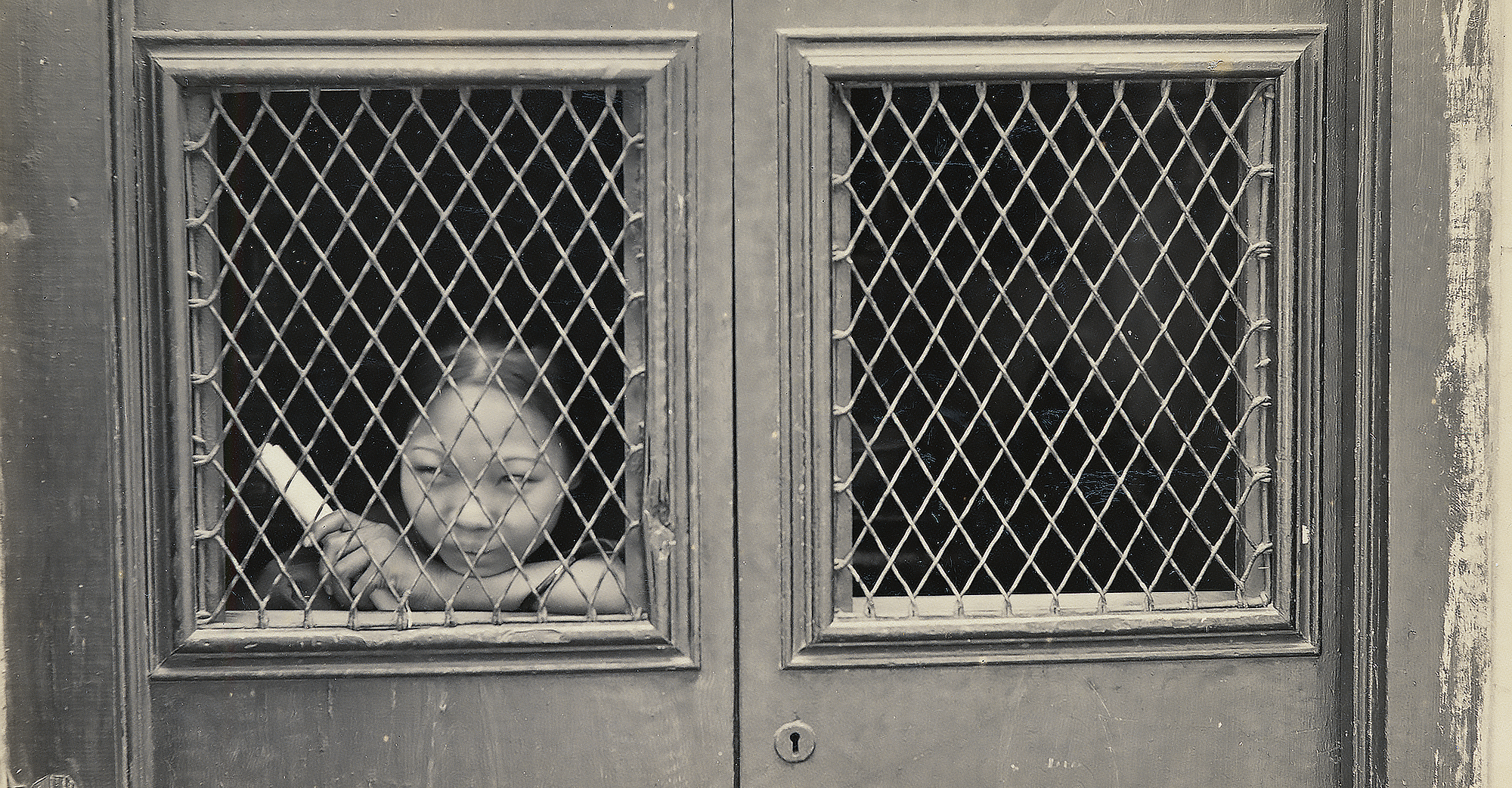The dead body of a Chinese woman was found last Tuesday morning lying across the sidewalk in a very uncomfortable position. The cause of her death could not be accurately ascertained, but as the top of her head was caved in, it is thought by some physicians that she died of galloping Christianity of the malignant California type
In the summer of 1870, when Chinese women remained relatively scarce in California, writer Ambrose Bierce penned this acerbic dispatch for the San Francisco News Letter and California Advertiser. Killing two birds with one stone, the consummate cynic offender was calling out an epidemic of callousness regarding the often sad fate of Chinese women out West.
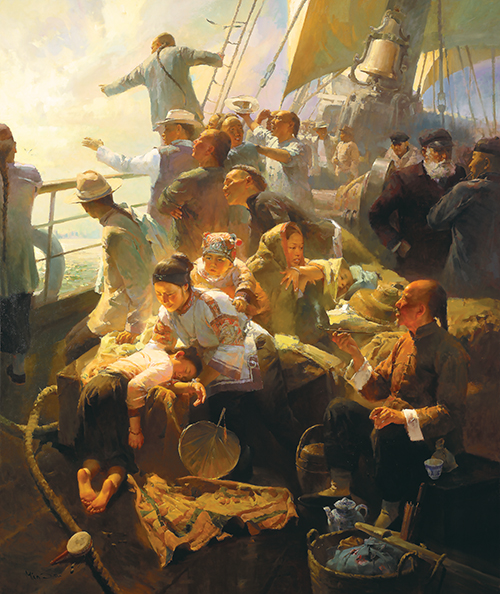
From the latter half of the 19th century through the early 20th century thousands of Chinese men left their homeland to seek their fortune amid the California Gold Rush and in its aftermath. As their stay in the United States was to be temporary, they left wives and family at home. In 1850, according to UC Santa Cruz professor Judy Yung’s book Unbound Feet: A Social History of Chinese Women in San Francisco, only seven of the 4,025 Chinese in the city were women. That dearth of female companionship created a natural market for prostitution, and Chinese girls soon began to flood into San Francisco.
Chinese secret societies known as the “tongs” oversaw prostitution in that city’s Chinatown from the beginning. Sworn brotherhoods of immigrants who offered protection and opportunity to new arrivals, the tongs were also notorious criminal enterprises. To furnish the burgeoning sex trade, its members kidnapped and bought Chinese girls. Business proved highly lucrative, and with their profits the tongs were able to extend their power, dominate immigrant neighborhoods and further expand the sex trade and other criminal activities.
Although some girls were kidnapped in China by bandits during such political upheavals as the mid-century Opium Wars and the 1850–64 Taiping Rebellion, other girls were sold into bondage by their own families. As daughters in Chinese households could neither furnish the hard manual labor required to support the family nor carry on the ancestral name, they were considered inferior to sons. Their inferior status in Chinese society at the time made them expendable, thus it was acceptable to dispose of them as circumstances warranted.
While a girl sold into prostitution in China might fetch as little as $50, one sold overseas was worth thousands of dollars, once under control of the tongs. Families facing economic hardship and starvation often made the decision to sell their daughters abroad in hopes of giving them the chance at a better life. Most girls in such circumstances accepted their family’s decision out of filial loyalty and allowed themselves to be sold to “labor contractors” in China. On arrival in San Francisco the young women were confined in holding pens called barracoons (from the Catalan word barraca, or “hut”), a practice originating with the African slave trade. The women purchased for tong brothels while still in China were handed over to their owners; those not yet sold were put up for auction.
On meeting their owners, the Chinese women, though often illiterate, were forced to sign papers that contracted them as prostitutes for four to six years. Some of the more attractive girls were “lucky” enough to become the concubines of wealthy owners, who might treat them decently, although if they failed to please, their masters could return them to the auction block. Others ended up in high-class brothels reserved for Chinese men, where they might also receive better treatment. But most of the girls wound up in “cribs”—shacks frequented by sailors, teen boys, day laborers and drunks, Chinese and white alike, who paid less than a half-day’s wages (25 to 50 cents) for their services.
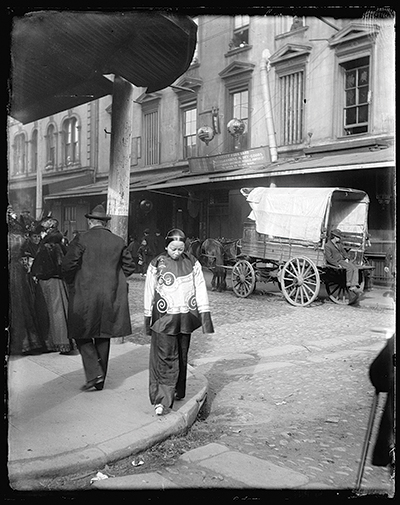
Conditions in the California brothels, concentrated primarily in San Francisco and Los Angeles, were terrible. Often mistreated by customers, the indentured girls received little care and no medical attention. Homesick and left untreated for venereal disease or other illnesses, most women were broken within a few years and rarely lasted more than five or six years in bondage. Some who started when they were 14 years old were dead before they reached 20, according to Chinese academics Yung and Lucie Cheng and the reportage of Gary Kamiya based on stories in the San Francisco Chronicle archives.
A dreadful ritual took place when a Chinese prostitute could not earn her keep. “When any of the unfortunate harlots is no longer useful, and a Chinese physician passes his opinion that her disease is incurable, she is notified that she must die,” the San Francisco Chronicle reported in 1869. The condemned was taken to a “hospital”—a dismal, windowless, unfurnished room in a Chinatown back alley. “A cup of water, another of boiled rice and a little metal oil lamp are placed by her side,” the Chronicle article continued. The proprietors then locked the heavy door. Days later, when the lamp had burned out, her executioners entered to remove the woman, who was usually dead from starvation or by suicide. In other cases the ailing prostitute was simply put out on the street to die. In 1870 the Daily Alta California reported that bodies of dead prostitutes littered the streets of Chinatown. Some chose to commit suicide by eating raw opium or jumping into the bay.
Despite the prevalence of such inhumane and appalling depravity, there is no record of local officials having taken any action to address the problem. As Chinese immigrants in California were generally regarded as inferior, it stood to reason that unfair and harsh treatment of Chinese women would not raise much concern with the general public. That said, women of all nationalities were certainly involved in prostitution in Gold Rush California. It was largely a world of men, most of whom had come to get rich quick, not to build families or permanent communities. A Chinese brothel owner could do better than almost all other Chinese businessmen in the state, making perhaps $2,500 a year on each prostitute, five times the average income of other occupations—e.g., cooking, tailoring or the laundry business—open to the Chinese. The tongs came to control prostitution in Chinatown just as they did the other major vice rackets, such as gambling and the opium trade. Between 1852 and 1873, the Hip Yee Tong, which started sex trafficking in the city, imported some 6,000 women and made an estimated $200,000 profit from the trade.
By 1860 upward of 85 percent of Chinese women in San Francisco were prostitutes. The situation had gotten so bad that the year prior police chief Martin Burke had deported a handful of prostitutes and cordoned off certain streets for propriety’s sake. But the tongs had local politicians in their pockets. In 1869, when 369 contracted Chinese slave girls arrived on a Pacific Mail steamer, Captain William Douglas of the San Francisco Police and 18 officers made a show of apprehending them at the Brannan Street docks, then took them straight to the Chinatown brothels. Eight months later, Douglas and his men did the same for another 246 girls who landed in San Francisco. As Chinese immigration increased, the ratio of prostitutes dropped to 71 percent by 1870 and 21 percent by 1880. While the federal Page Act of 1875 sought to prohibit the immigration of any women from “China, Japan or any East Asian country” suspected of prostitution, the tongs and their enablers widely ignored its provisions. The Chinese Exclusion Act of 1882 went even further, prohibiting the immigration of all Chinese laborers, yet Chinese women continued to slip into the country illegally with the complicity of corrupt politicians and policemen, fueling a second wave of prostitution that swept through the state.
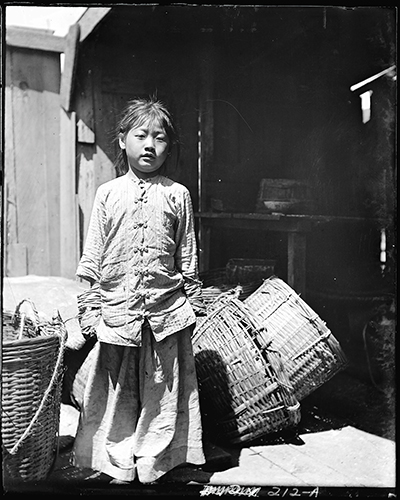
While most Chinese female immigrants out West were concentrated in San Francisco, a seaport with a large Chinatown, they were sent or traveled elsewhere as well. By 1860, there were 425 Chinese in Oregon, though relatively few of the women were prostitutes owned by the tongs. The provisions of the Page Act proved largely irrelevant, as many of the enslaved Chinese women in Oregon were concubines, mistresses or secondary wives, not technically prostitutes.
Many of the Chinese women in Nevada, on the other hand, were prostitutes, who often lived and worked inside opium dens. While some had chosen the trade, many others were forced into it without pay, as the only alternatives were to run away or end their lives. When recaptured in the Nevada hills, one runaway was brought in with frozen feet in need of amputation yet courted death by refusing to take medicine or food. A 19th-century Virginia City paper reported the mass suicide of six Chinese prostitutes desperate to escape enslavement.
Chinese prostitutes in Idaho Territory were also known to try to escape, sometimes with the help of lovers. Because of the high value placed on prostitutes, owners went to great expense to recover their “property,” sometimes enlisting the aid of the tongs to track them down. The women usually faced arrest, though authorities would drop the charges and release the prisoners once their owners had posted bail.
Not all prostitutes met horrible fates. “China Annie” was one such exception. Owned by a member of Idaho City’s Yeong Wo Co., which controlled many prostitutes, she escaped to Boise in the 1870s to marry her Chinese lover, Ah Guan. Incredibly, her owner charged the lovestruck fiancé with kidnapping the captive Chinese girl, who was apprehended and brought to court. Sympathetic to the couple’s plight, the judge dismissed the case and even arranged for them to be married then and there in the courthouse. About a dozen Chinese prostitutes operated in Idaho City, while in Boise most of the Chinese women, like Annie, were married to wealthy Chinese men, many of whom also had wives back home. As elsewhere, in Idaho Territory many Chinese women considered prostitutes by white society were closer to being concubines.
Chinese women probably had it best in Deadwood, Dakota Territory. That mining boomtown’s resident German doctor, Henrich Alexander Leopold von Wedelstaedt, was the only white member of a Chinese Masonic lodge he had founded, while Mayor Sol Star, a German Jew from Munich, was notably kind to fallen women, though he himself never married. Neither man excluded the Chinese, men or women, from medical or legal protection. Though there were some Chinese-operated brothels in town, many Chinese men who had come to prospect went on to open such legitimate businesses as laundries, restaurants and shops. The provisions of the Chinese Exclusion Act prevented Chinese bachelors in Deadwood from requesting wives sent from their homeland, thus most single Chinese women in town were either prostitutes or servants. That said, they were seldom neglected or persecuted. The tongs in Deadwood largely steered clear of violence or criminal activity, instead helping the Chinese community as originally intended. The only records of tong violence were fights waged against the relatively small anti-Chinese faction in the community. The Chinese in Deadwood even had their own fire company, with a hand-drawn, hand-pumped engine that drew cheers whenever the fire companies staged foot races down the main street.
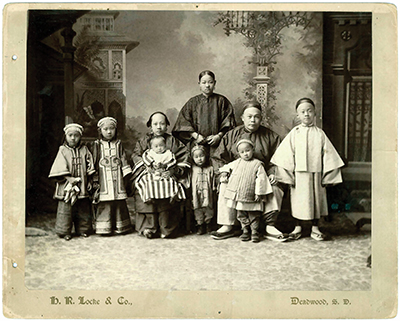
Respected figures in the Chinese community also won regard in the community at large. On a New Year’s Day visit with her mother to the home of Wing Tsue (aka Fee Lee Wong), the leading Chinese merchant of the time, young Estelline Bennett expressed her awe at seeing Wing Tsue’s wife, Hal Shek Wong, for the first time:
Mrs. Wing Tsue herself was the loveliest bit of exquisite china I ever saw. She was painted and mascaraed in a way no nice American woman could understand in those days, but on her the effect was charming. Her black hair was built in a high pyramid with gorgeous pins and combs. Her brilliant silk jacket and trousers were heavy with embroidery, and her tiny, useless little feet were encased in embroidered satin shoes with wooden soles.
Estelline’s father, Territorial Supreme Court Associate Justice Granville G. Bennett, was a Civil War veteran and devout Christian especially familiar with 13th Amendment passages regarding bondage. Any captive Chinese girl who could prove she was being held against her will would be automatically freed, and any Chinese who sought the judge’s service were given fair trials. When serving as defense counsel, he once got a Chinese man acquitted for injuring a white man in a fight over a white woman when he demonstrated the white man “had a bad record in the Badlands.” The Chinese community sent cooks and waiters to Bennett’s home whenever he gave a formal dinner. The Tsues’ four daughters and two sons all attended Deadwood schools.
Deadwood authorities showed remarkable diligence when investigating the 1877 death of Di Gee, a wealthy Chinese woman who owned three well-furnished homes in town. Gee had suffered a stab wound to the sternum with a small knife and deadly blows to the face with the blunt end of a hatchet (see “Death of Deadwood’s China Doll,” by Jerry Bryant and Bill Markley). Unlike San Francisco officials, who often shrugged off the discovery of dead Chinese women, Deadwood authorities had Gee’s corpse taken to the coroner for an inquest. And while they never apprehended the murderer(s) or determined a motive, they did conduct a proper investigation, followed by a funeral and proper burial. In San Francisco, her corpse might have been unceremoniously dumped in a hole.
In time circumstances for some Chinese women in San Francisco improved. Take, for example, the story of Tye Leung, born in that city in 1887 to a father who was a cobbler and a mother who ran a boardinghouse. After volunteering for the Presbyterian Mission Home for rescued Chinese prostitutes (see sidebar below), Leung went on to be the first Chinese American to pass the civil service examinations and worked as an assistant to the matron at Angel Island Immigration Station. On May 14, 1912, participating in that year’s presidential election, she cast a ballot in San Francisco, the San Francisco Examiner hailing her as “the first Chinese woman in the history of the world to exercise the electoral franchise.” Angel Island immigration inspector Charles Schulze married Leung in October 1913, but the ceremony was held in Vancouver, Wash., as at the time intermarriage of Chinese and white Americans was illegal in California. WW
Donaldina Cameron was a 19th-century social reformer who came to aid of Chinese women in San Francisco and became known as Chinatown’s “Angry Angel.” Born into a Scottish family in New Zealand on July 26, 1869, she moved with her family to the United States at age 2 and in 1895 moved to San Francisco, where she volunteered at Maggie Culbertson’s Mission Home, a Presbyterian shelter for rescued Chinese prostitutes run by the Woman’s Occidental Board of Foreign Missions. When Culbertson died in 1897, Cameron took over as superintendent of the home, managing educational programs for the young women until her retirement in 1934. She also organized raids to liberate female captives from brothels and gambling clubs. On occasion Donaldina herself went undercover into these squalid places, risking discovery and retribution by the powerful tongs, who were reluctant to kill whites out of fear of reciprocal massacres. Cameron faced an uphill battle to keep custody of the working girls, as San Francisco courts would often turn them back over to their owners, who claimed them as relatives or willing participants. At the mission home the young Chinese women were taught sewing, cooking and various legal functions, as well as how to pray and behave as proper Christians. Curiously, despite having devoted her life to the rescue of Chinese captives, Cameron neither exhibited personal attachment to the Chinese nor appeared particularly fond of their culture, often referring to them as “heathens.” Neither did she make any effort to learn their language. In 1942, under new ownership, the home was renamed the Donaldina Cameron House. Cameron died on Jan. 4, 1968, at the venerable age of 98. Cameron House [cameronhouse.com] continues to operate in the city’s Chinese community, fostering Christian fellowship through programs in youth sports, tutoring and counseling. —Lynn Yuan 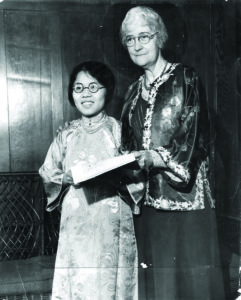
Lynne Yuan grew up in Shanghai and in greater New York City and is fluent in Mandarin and English, with published translation experience for New York magazines. For this article she used Chinese-language sources, archived articles from the San Francisco Chronicle and the writings of Judy Yung and the late Lucie Cheng.

